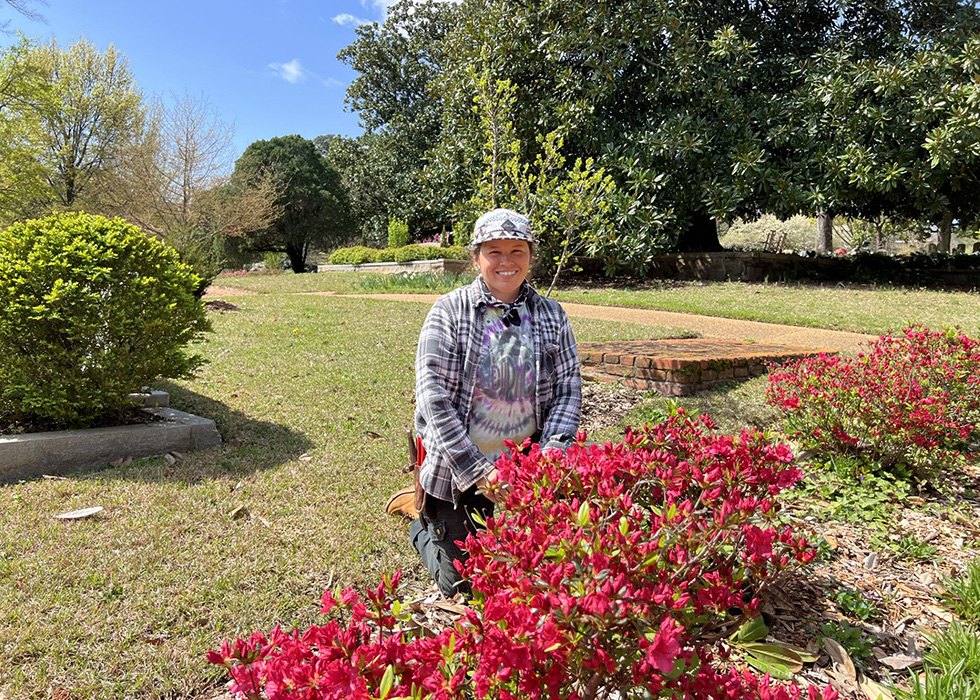
Dogwoods! Which one?
Dogwoods come in all shapes and sizes, from shrubs with brightly colored winter stems to our native flowering dogwood (Cornus florida) with it’s beautiful white and pink spring flowers. The flowering dogwood is a classic of southern springs, but you can extend the flowering season by including other members of the family.
It’s a little too early for flowering dogwood here in Atlanta but the Cornelian cherry (Cornus mas) is in full bloom, brightening the final days of winter. This lesser-known dogwood is covered with clusters of small, bright yellow flowers before the leaves emerge. Our trees are young but the bright yellow flowers allow even a small tree to stand out in the landscape. The ¾” red fruit is edible and used for jam making, but they are most often left for our birds to enjoy. This 20’ tree develops coppery, exfoliating bark as the tree matures, providing interest year-round. You can see one on the right as you enter the front gate and others are planted near the fountain.

It’s worth noting that these yellow flowers are the true dogwood flowers. Most dogwoods have small yellow-green flowers with narrow petals. The white “petals” we associate with our native dogwoods are actually modified leaves that the plant uses to attract pollinators.
We know that spring has arrived when the flowering dogwoods (Cornus florida) bloom. Considered one of the most beautiful of our native trees, the flowers welcome spring before the bright green leaves emerge. These leaves will turn to shades of scarlet and burgundy as summer ends and will drop to show off the scarlet fruits so loved by our birds.


Our dogwoods are prized for more than their beauty. A scarlet dye can be extracted from the roots and the extremely dense wood is prized by woodturners and tool makers. Both strong and smooth, it was favored for darning eggs and weaving shuttles, often called “dogs”. Native Americans used the aromatic bark and roots in many ways. A tea was made to treat malaria and diarrhea and a poultice was used to treat wounds. Little used today, both remedies were adapted by Southern troops when quinine was unavailable.
Beautiful, useful, and to many spiritual, the dogwood has also come to symbolize the crucifixion, especially in the South where its blooms appear around Easter.

“The legend holds that the tree was once very large, like a Great Oak tree, and because its wood was strong and sturdy, it provided building material for a variety of purposes. According to the story, it was the dogwood tree that provided the wood used to build the cross on which Jesus was crucified. Because of its role in the crucifixion, it is said that God both cursed and blessed the tree. It was cursed to forever be small, so that it would never grow large enough again for its wood to be used as a cross for a crucifixion. Its branches would be narrow and crooked–not good for building at all. At the same time, however, the tree was blessed so that it would produce beautiful flowers each spring, just in time for Easter. To remember God’s promise to the tree it is said he gave it a few traits so that whoever looks upon it will never forget. The petals of the dogwood actually form the shape of a cross. Upon close examination, it can be seen that the blooms of the tree always have four petals. The middle of the Dogwood flower has a tight grouping of resembling a “crown of thorns.” And the tips of each of the petals are indented, as if they bear a nail dent. There are even colors in the petals that bring to mind the drops of blood that spilled during the crucifixion.” www.plantgeek.com
Sadly, these beautiful trees are subject to diseases and warming temperatures. They are becoming harder to grow in the Atlanta area and are being crossed with Cornus kousa to provide hybrids that are more adapted.
The Kousa Dogwood (Cornus kousa) blooms almost a month later, extending the dogwood season into early summer. It is a handsome, medium sized tree with beautiful, star-like white flowers, attractive fall color, and lovely winter bark. Fairly uncommon in the past, Kousa dogwoods and their hybrids have become mainstream and are readily available in nurseries. Cornus kousa is more disease resistant than our native but, while beautiful, it doesn’t have the same spring display. The hybrids have many of the best traits from both parents. Our trees are the true species and lovely examples grow next to the Guard House and between the fountain and Bell Tower.
This dogwood’s strawberry-like, sweet-flavored fruit is much showier than the fruit of other dogwoods but is filled with seeds. This makes it quite tedious to prepare however recipes for jams and baked goods are available.



